After successfully acquiring Vizio, LeTV released a super-sized smart TV in the United States. As another high-end product following uMax120, LeTV Super-TV uMax85 has made a significant improvement in process design, hardware attributes, core technologies, and functional performance. Although the high-end product has not yet appeared in the domestic market, the product has already received the Gold Medal for Internet TV Solutions at IFA 2016 in Germany, and it is enough for the majority of consumers to look forward to the record of first-time purchases that have been sold in the United States for nine seconds.
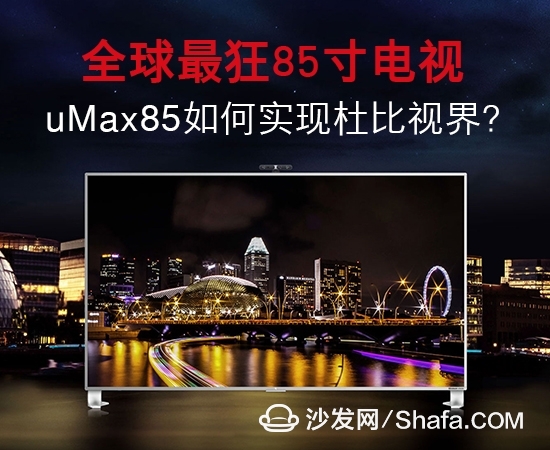
The increasing consumer demand is driving the transformation of the home appliance industry to high-end. Taking TV as an example, the measurement of high-end quantifiable standards is nothing more than the product's process design, hardware attributes, core technologies, and functional performance. Only four important reference indicators are Outstanding performance products can be regarded as high-end home appliances.
Of course, if you want to make high-end home appliances gain more attention from consumers and get a bigger market share, how to achieve “more understanding†of consumers is indispensable, and in this regard, LeTV will undoubtedly walk on other competitors. The front end.
Although the "entry" time is not long, with the "more understanding" of consumer demand for operating systems and content services, LeTV Super TV has quickly won the recognition of consumers. With the substantial increase in the domestic market share, LeTV’s business landscape has begun to expand overseas.

On December 20th, LeTV officially launched the ultra-television uMax85 in China. What is the difference between this product and the uVideo TV uMax85 previously released in the United States? With many questions, we visited the LeTV Super TV R&D Center and provided the core data of LeTV Super TV uMax85 TV for the majority of consumers.
LeTV Super TV uMax85 body design full metal build
"Shock" is the first impression made by LeTV super-TV uMax85 to the author. Although the large screen has gradually become mainstream in recent years, it is undeniable that more than 70-inch products with a mass production scale are still very few. According to relevant technical personnel, the specification of the product is 1904mm*1088mm*60mm, and the screen brought by such a giant screen is even more shocking.
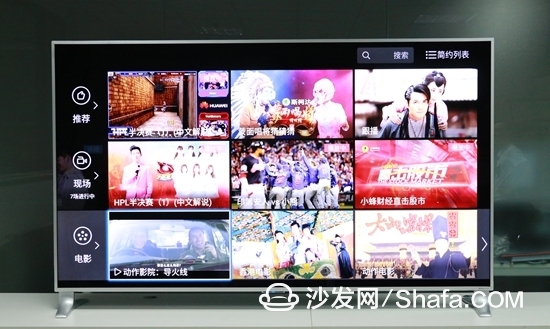
As mentioned before, LeTV Super TV uMax85 excels in the process design of its products. Through its all-metal frame design, it is highly technical to create products. Not only that, while the all-metal body highlights the texture of the product, the all-aluminum alloy fin base effectively improves the product's structural stability and security.
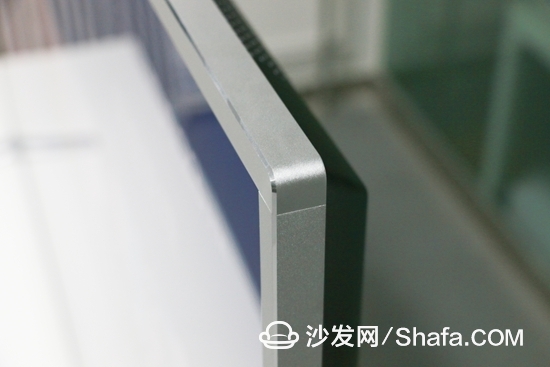
Of course, there is a very narrow border design and the addition of drilling and cutting technology, which can visually make the screen appear larger, more impactful and aesthetically pleasing. In addition to its distinctive features, the LeTV Super TV uMax85 does not have any cumbersome outfits, making the product look more noble and atmospheric.
In terms of interfaces, LeTV Ultramax uMax85 provides consumers with multiple interfaces such as HDMI interface, USB interface, and network interface, enriching consumers' daily entertainment choices. For example, an over-the-top USB interface can extend the somatosensory camera. Somatosensory games, long-distance calls, joining game stands or handles, and more.


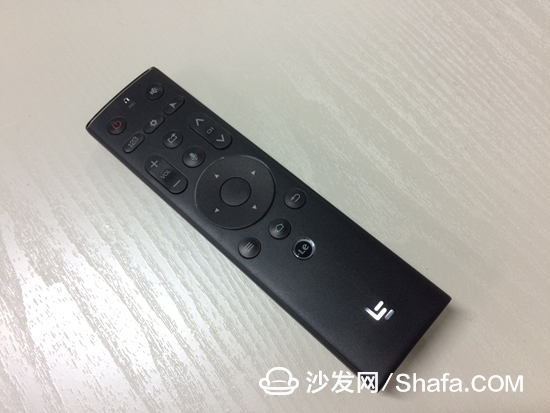
Finally, let's talk about the personalized design of LeTV super-TV uMax85, such as the unique cloud fin base, which is simple but without losing the sense of technology. Another example is the polished border rounded design, which greatly enhances the product's own security properties. Of course, there are rare metal panel remote controls in the industry. In addition to the continuation of the simple style, simple operation, one-touch direct, and easy to use, the new metal appearance is also in harmony with the overall design of the TV.
In general, as a high-end product, the avant-garde design concept, full materials for workmanship, and high safety factor are the main impressions that LeTV Ultramax TV brings to consumers.
LeTV Super TV uMax85 Dolby Trials Dolby Vision Technology
The bold innovation in appearance is the first step in attracting more consumers' attention. The key to winning consumer recognition and achieving good results lies in the “hard power†of the product itself. Dolby Vision is currently the strongest software and hardware solution.

The first is the panel definition. With the optimization of the 4K panel and the Mstar6A938 smart chip, the LeVideo ultra-theater uMax85's display screen can naturally restore the picture while providing consumers with a more realistic and impactful visual experience.
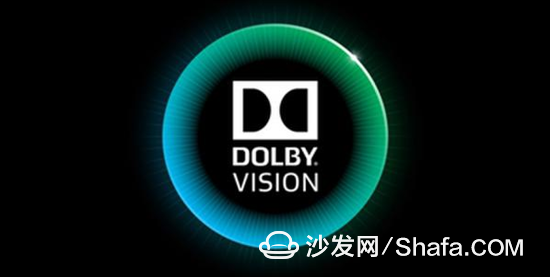
Dolby Vision's Dolby Vision technology allows the screen brightness to be more than 40 times that of ordinary video, allowing users to experience a wider range of brightness dynamics, brighter colors and purer natural blacks. From a technical perspective, Dolby Vision is the highest standard for HDR technology. Especially when the Hollywood blockbusters are almost always equipped with Dolby Vision technology, choosing the UltraTV uMax85 means that consumers can truly feel the shock of Hollywood blockbusters. As the industry's hottest keywords in 2016, HDR performance of TVs has undoubtedly become the focus of consumers.
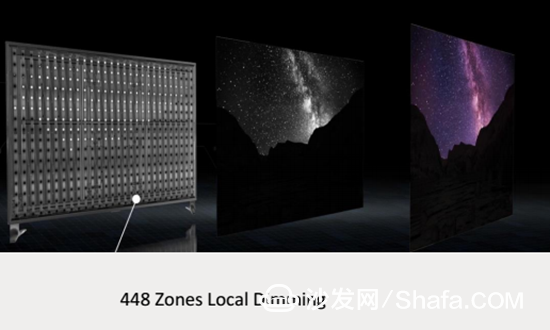
In fact, these are not the essence of LeTV Super TV uMax85, the product can achieve the core of Dolby vision is 448 partitions of light control technology. Dynamic zone light control technology can control the brightness of each LED backlight zone. The original digital-analog hybrid light control technology achieves 16-bit grayscale light control to enhance the brightness and darkness of the picture and display the layering of the picture more finely. .

Due to the different imaging principles, LCD TVs are inevitably subject to dynamic afterimages. For this reason, many LCD TVs have added dynamic compensation technology. For example, we introduced the UltraTV uMax85 in the same year. With the addition of Fluid Motion 1920 high-speed backlight control technology and MEMC dynamic picture processing technology, LeTV Super TV uMAX85 can effectively eliminate motion picture. The phenomenon of jitter, tailing, etc., optimizes the dynamic picture while bringing consumers an even more fluid viewing experience.
From the many technical introductions of products, LeTV Super-TV uMax85 can be said to be full of sincerity, creative process design combined with many of the industry's top black technology, for consumers to create a rare high-end products in the industry. So what is the real strength of music super TV uMax85? Later on, we will in-depth experience of LeTV Super TV uMax85, close to understand the unique charm of LeTV Super TV uMax85.
The Key to Realizing Dolby Vision: 448 Accurate Control of Light
As an Internet TV brand that starts with content and services, its powerful content strength does not need much to say. In today's product experience, the author only wants to talk about the performance of the product with the majority of consumers, after all as a display output. Equipment, the strength of the display capacity determines the final trend of the product in the market, then the music as super TV uMax85 performance in the end how?
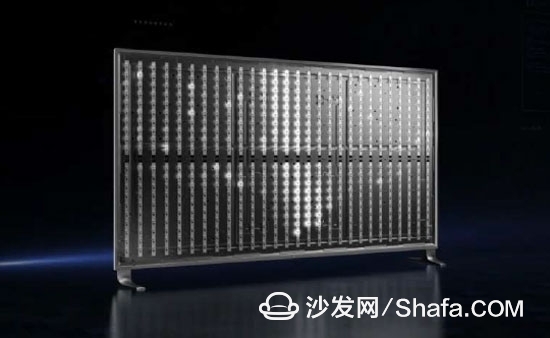
The first is accurate light control technology. Consumers who understand the molecular structure of LCD TVs know that almost all LCD TVs cannot achieve precise control of backlight sources, whether they are direct-type or side-in. In particular, LCDs with side-entry backlights are more likely to suffer from serious lack of color purity and uniformity due to lack of controllability in light control. Although in this respect, direct-lit backlight LCD TVs perform better, but they can only meet the viewing needs of ordinary consumers. Once they encounter enthusiastic consumers who are “criticalâ€, they are comparable to the “disaster†quality. Performance is hard to impress enthusiastic consumers.
In order to enhance the precise control of the TV, the real and effective restoration of the image, LeTV super-TV uMax85 will be divided into 448 sub-standard LCD partitions, which is currently available on the market with the most control of light control technology. Through the digital-analog hybrid light control of the LEDs, higher and more detailed picture layering is achieved (this is also LeTV's patent, uMax85's housekeeping capability). Of course, one point that needs to be emphasized here is that the multi-zone light control technology must be implemented in a direct-type LED backlight LCD TV, and even a structured side-entry LED backlight LCD TV cannot achieve such effects.
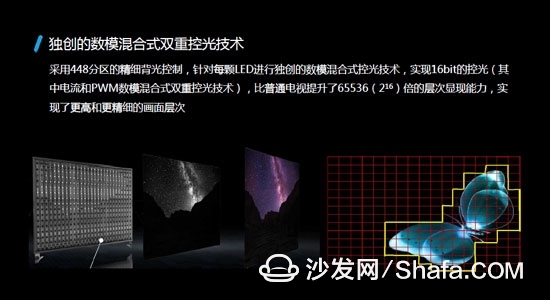
Of course, there are also some cutting-edge products that incorporate regional light control technology. However, due to the very limited number of partitions, the actual performance of the screen cannot be compared with the 448 division-controlled LeTV super TV uMax85.
Not only that, LeTV super-TV uMax85 also added 4K MEMC dynamic image compensation technology, combined with 448 independent partition backlight Fluid Motion 1920 speed backlight control technology, can achieve accurate capture of each action, and the use of Fluid Motion 1920 high-speed backlight scanning Technology brings more fluid motion to consumers.
Dolby Vision's Most Powerful Video Solution Nowadays
In the previous article, we mentioned a very critical standard - Dolby Vision Dolby Vision. What is the standard and what impact does it have on the television industry? With questions, let's first look at the hottest keyword in the color TV industry in 2016 – HDR.
HDR is a high dynamic range, which can display more details of highlights and shadows, while bringing richer colors and more in-depth and natural details to the picture, thus making the television picture closer to the human eye. Due to differences in concepts and standards, the format of HDR is mainly focused on Dolby Vision and HDR10. What is the difference between the two?

As the leader in the development of cinema technology today, Dolby is the first HDR technology to be put into use. The core of this technology is the "perceptual conversion" (PQ) of the electro-optical conversion function, its biggest highlight is to customize the brightness standard in 10000Nits (normal TV brightness is only about 100-200Nits). But currently no display device can achieve this brightness, so the current Dolby Vision brightness target is a more practical 4000Nits. In addition, recordings made with Dolby Vision also include up to 12-bit color depth. From the standpoint of overall performance, movies processed and transmitted by Dolby Vision are the best in terms of sound and picture effects, which is very much in line with the demand for audiophiles' purchases.
However, since Dolby Vision's entire solution is designed with a large number of patented technologies, the cost is relatively high. In order to save the patent fee, an HDR10 evolved from Dolby Vision has entered the realization of people. As a "perceptual transformation" (PQ) based on the same core technology functions as Dolby Vision, the HDR10 is similar to the Dolby standard in brightness, color, etc. The only difference is that the HDR10 only supports 10-bit color depth and is a There are no hard level indicators for open standards, just support HDR10 decoding. Dolby Vision has rigid standards. The maximum brightness needs to reach a very high brightness, while the minimum brightness reaches a very low brightness, and the color information needs to support and support 10-12bit. The difference in this standard directly leads to the screen restoration accuracy is not The same day.
In order to facilitate everyone to have a clearer understanding of the two, the author here also made a summary for the majority of consumers.
First of all, from the point of view of the technology itself, the hardware solutions used by Dolby Vision are more advanced, and better restoration accuracy is achieved through frame-by-frame rendering. Secondly, in terms of actual results, the evaluation reports currently available all indicate that Dolby Vision looks more natural and there will be no HDR10 glare. Thirdly, the HDR10 has a wider range of options for content and peripheral support. It can use UHD 4K Blu-ray and enjoy online streaming media. Dolby Vision is currently only available through Netflix, VUDU and Amazon online streaming media.
It is not difficult to see that as one of the few top-level Dolby Vision standard uMax85 super-video in the image restoration, color performance, color depth contrast and other performance can be described as difficult opponent.
Comparison of LeTV HDR
Strictly speaking, HDR is not a hardware technology. We should think of it as a video format and concept. To really feel the perfect performance of HDR, you need to upgrade everything from content to hardware, that is, from the shooting, production, editing, transmission, and display of film and television content. Throughout the process, you have a powerful content production team and The music video streaming media CDN technology and high-end TV terminal design capabilities are undoubtedly the best.

As a flagship product, the LeTV SuperTV uMax85 perfectly supports the Dolby Vision and HDR10 dual-standards, and the wider dynamic range creates a perfect picture quality performance. In addition, in conjunction with the 1000Nit intelligent peak light control technology, the super-high dynamic contrast is achieved while taking into account the comfort of human eyes when viewed.
LeTV uMax85 supports DCI-P3 color gamut/10bit color depth, than traditional BT. The 709 standard has increased by 26% to meet the digital cinema-level colors and standards.



In addition, LeTV Super TV uMax85 not only provides native support for content, but also uses SDR-to-HDR processing technology for SDR content, statistical image grayscale and other color information, reconstruct image frame contrast, color, details, combined with the accuracy of the 448 partition Backlight dynamic control to achieve close HDR display.
As the author mentioned in the previous article, the HDR TV standards that are currently on the market are not the same, but the uMax85, which has dual standards, is not intended to have the highest standards. It is necessary to know that Hollywood movies are produced using Dolby Vision content. Method, so you want to see authentic Hollywood blockbusters, only choose to support Dolby Vision TV.
LeTV Super TV uMax85 hardware configuration hardware competition difficult to find rivals
Of course, in order to realize many of the above-mentioned performances, in addition to the continuous improvement of technology, the collocation on the hardware is also particularly critical. For this reason, LeTV super-TV uMax85 has added a few Mstar 6A938 smart TVs that can support Dolby Vision. chip. With the addition of the current highest-end smart TV chip, the LeTV Super TV uMax85 is also rated as the top in terms of overall configuration.
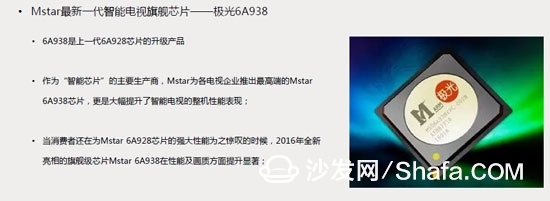
The Mstar 6A938 chip uses the A72+A53 big. LITTLE architecture of the 64-bit processor, can be more efficient processing of images and image processing principles, from the perspective of the product's hardware configuration, music as super TV uMax85 is also very rare in the same level of products.
Not only that, the new smart TV chip has a clear optimization of the TV's own display performance. In combination with the top 4K color processing engine, ultra-high-definition screens are now showing up.
It is precisely because of the support of powerful hardware that LeTV Super TV uMax85 has been improved in the dynamic display effect. The use of 4K 120Hz MEMC dynamic compensation technology effectively solves the smearing phenomenon of the dynamic picture and eliminates the dynamic situation of the picture.
Of course, there are still a number of technologies that we know well in LeTV's uMax85, such as the 4K enamel engine image processing technology. 265 4K decoding technology, etc., the addition of many technologies has provided great help for the daily use of consumers, giving consumers more shocking images, while enhancing the overall viewing experience of consumers.
Test Summary: uMax85 Heavy Tree Industry Standard
In order to create high-quality TVs for consumers, LeTV will further optimize and create process design, hardware attributes, core technologies and functional performance of its products. In particular, with the successful acquisition of Vizion, LeTV's performance in hardware and picture quality of its products has increased significantly.
As the strongest support for Dolby Vision's Dolby Vision's music super TV uMax85, the visual impact of its shocking picture goes without saying. In addition, the addition of numerous patented technologies has also provided powerful support for the LeTV Super TV uMax85, such as the 448-zone dynamic backlight technology. According to the data released at present, the 448 partition is the highest one at present, and through the fine backlight control of the 448 partition, the original digital-analog hybrid light control technology for the LED has been improved 216 times more than the ordinary TV.
The uMax120 was released at the end of 2015 in the same school. In 2016, LeTV brought uMax85. If uMax120 represents the world's largest single-screen LCD TV, then uMax85 represents the top 80-inch product. Performance is not an exaggeration.
For the color TV market that has long been monopolized by traditional home appliance companies, the launch of the LeTV Super TV uMax85 is of extraordinary significance. Its appearance has raised the hardware and picture quality of the product to a higher level, and on the other Establishing industry standards also gives consumers a better choice.
Smart TV/box information can focus on smart TV information network sofa butler (http://), China's influential TV box and smart TV website, providing information, communication, TV boxes, smart TVs, smart TV software, etc. Answering questions.

Of course, if you want to make high-end home appliances gain more attention from consumers and get a bigger market share, how to achieve “more understanding†of consumers is indispensable, and in this regard, LeTV will undoubtedly walk on other competitors. The front end.
Although the "entry" time is not long, with the "more understanding" of consumer demand for operating systems and content services, LeTV Super TV has quickly won the recognition of consumers. With the substantial increase in the domestic market share, LeTV’s business landscape has begun to expand overseas.

LeTV Super TV uMax85 body design full metal build
"Shock" is the first impression made by LeTV super-TV uMax85 to the author. Although the large screen has gradually become mainstream in recent years, it is undeniable that more than 70-inch products with a mass production scale are still very few. According to relevant technical personnel, the specification of the product is 1904mm*1088mm*60mm, and the screen brought by such a giant screen is even more shocking.


In terms of interfaces, LeTV Ultramax uMax85 provides consumers with multiple interfaces such as HDMI interface, USB interface, and network interface, enriching consumers' daily entertainment choices. For example, an over-the-top USB interface can extend the somatosensory camera. Somatosensory games, long-distance calls, joining game stands or handles, and more.



In general, as a high-end product, the avant-garde design concept, full materials for workmanship, and high safety factor are the main impressions that LeTV Ultramax TV brings to consumers.
LeTV Super TV uMax85 Dolby Trials Dolby Vision Technology
The bold innovation in appearance is the first step in attracting more consumers' attention. The key to winning consumer recognition and achieving good results lies in the “hard power†of the product itself. Dolby Vision is currently the strongest software and hardware solution.




From the many technical introductions of products, LeTV Super-TV uMax85 can be said to be full of sincerity, creative process design combined with many of the industry's top black technology, for consumers to create a rare high-end products in the industry. So what is the real strength of music super TV uMax85? Later on, we will in-depth experience of LeTV Super TV uMax85, close to understand the unique charm of LeTV Super TV uMax85.
The Key to Realizing Dolby Vision: 448 Accurate Control of Light
As an Internet TV brand that starts with content and services, its powerful content strength does not need much to say. In today's product experience, the author only wants to talk about the performance of the product with the majority of consumers, after all as a display output. Equipment, the strength of the display capacity determines the final trend of the product in the market, then the music as super TV uMax85 performance in the end how?

In order to enhance the precise control of the TV, the real and effective restoration of the image, LeTV super-TV uMax85 will be divided into 448 sub-standard LCD partitions, which is currently available on the market with the most control of light control technology. Through the digital-analog hybrid light control of the LEDs, higher and more detailed picture layering is achieved (this is also LeTV's patent, uMax85's housekeeping capability). Of course, one point that needs to be emphasized here is that the multi-zone light control technology must be implemented in a direct-type LED backlight LCD TV, and even a structured side-entry LED backlight LCD TV cannot achieve such effects.

Not only that, LeTV super-TV uMax85 also added 4K MEMC dynamic image compensation technology, combined with 448 independent partition backlight Fluid Motion 1920 speed backlight control technology, can achieve accurate capture of each action, and the use of Fluid Motion 1920 high-speed backlight scanning Technology brings more fluid motion to consumers.
Dolby Vision's Most Powerful Video Solution Nowadays
In the previous article, we mentioned a very critical standard - Dolby Vision Dolby Vision. What is the standard and what impact does it have on the television industry? With questions, let's first look at the hottest keyword in the color TV industry in 2016 – HDR.
HDR is a high dynamic range, which can display more details of highlights and shadows, while bringing richer colors and more in-depth and natural details to the picture, thus making the television picture closer to the human eye. Due to differences in concepts and standards, the format of HDR is mainly focused on Dolby Vision and HDR10. What is the difference between the two?

However, since Dolby Vision's entire solution is designed with a large number of patented technologies, the cost is relatively high. In order to save the patent fee, an HDR10 evolved from Dolby Vision has entered the realization of people. As a "perceptual transformation" (PQ) based on the same core technology functions as Dolby Vision, the HDR10 is similar to the Dolby standard in brightness, color, etc. The only difference is that the HDR10 only supports 10-bit color depth and is a There are no hard level indicators for open standards, just support HDR10 decoding. Dolby Vision has rigid standards. The maximum brightness needs to reach a very high brightness, while the minimum brightness reaches a very low brightness, and the color information needs to support and support 10-12bit. The difference in this standard directly leads to the screen restoration accuracy is not The same day.
In order to facilitate everyone to have a clearer understanding of the two, the author here also made a summary for the majority of consumers.
First of all, from the point of view of the technology itself, the hardware solutions used by Dolby Vision are more advanced, and better restoration accuracy is achieved through frame-by-frame rendering. Secondly, in terms of actual results, the evaluation reports currently available all indicate that Dolby Vision looks more natural and there will be no HDR10 glare. Thirdly, the HDR10 has a wider range of options for content and peripheral support. It can use UHD 4K Blu-ray and enjoy online streaming media. Dolby Vision is currently only available through Netflix, VUDU and Amazon online streaming media.
It is not difficult to see that as one of the few top-level Dolby Vision standard uMax85 super-video in the image restoration, color performance, color depth contrast and other performance can be described as difficult opponent.
Comparison of LeTV HDR
Strictly speaking, HDR is not a hardware technology. We should think of it as a video format and concept. To really feel the perfect performance of HDR, you need to upgrade everything from content to hardware, that is, from the shooting, production, editing, transmission, and display of film and television content. Throughout the process, you have a powerful content production team and The music video streaming media CDN technology and high-end TV terminal design capabilities are undoubtedly the best.

LeTV uMax85 supports DCI-P3 color gamut/10bit color depth, than traditional BT. The 709 standard has increased by 26% to meet the digital cinema-level colors and standards.



As the author mentioned in the previous article, the HDR TV standards that are currently on the market are not the same, but the uMax85, which has dual standards, is not intended to have the highest standards. It is necessary to know that Hollywood movies are produced using Dolby Vision content. Method, so you want to see authentic Hollywood blockbusters, only choose to support Dolby Vision TV.
LeTV Super TV uMax85 hardware configuration hardware competition difficult to find rivals
Of course, in order to realize many of the above-mentioned performances, in addition to the continuous improvement of technology, the collocation on the hardware is also particularly critical. For this reason, LeTV super-TV uMax85 has added a few Mstar 6A938 smart TVs that can support Dolby Vision. chip. With the addition of the current highest-end smart TV chip, the LeTV Super TV uMax85 is also rated as the top in terms of overall configuration.

Not only that, the new smart TV chip has a clear optimization of the TV's own display performance. In combination with the top 4K color processing engine, ultra-high-definition screens are now showing up.
It is precisely because of the support of powerful hardware that LeTV Super TV uMax85 has been improved in the dynamic display effect. The use of 4K 120Hz MEMC dynamic compensation technology effectively solves the smearing phenomenon of the dynamic picture and eliminates the dynamic situation of the picture.
Of course, there are still a number of technologies that we know well in LeTV's uMax85, such as the 4K enamel engine image processing technology. 265 4K decoding technology, etc., the addition of many technologies has provided great help for the daily use of consumers, giving consumers more shocking images, while enhancing the overall viewing experience of consumers.
Test Summary: uMax85 Heavy Tree Industry Standard
In order to create high-quality TVs for consumers, LeTV will further optimize and create process design, hardware attributes, core technologies and functional performance of its products. In particular, with the successful acquisition of Vizion, LeTV's performance in hardware and picture quality of its products has increased significantly.
As the strongest support for Dolby Vision's Dolby Vision's music super TV uMax85, the visual impact of its shocking picture goes without saying. In addition, the addition of numerous patented technologies has also provided powerful support for the LeTV Super TV uMax85, such as the 448-zone dynamic backlight technology. According to the data released at present, the 448 partition is the highest one at present, and through the fine backlight control of the 448 partition, the original digital-analog hybrid light control technology for the LED has been improved 216 times more than the ordinary TV.
The uMax120 was released at the end of 2015 in the same school. In 2016, LeTV brought uMax85. If uMax120 represents the world's largest single-screen LCD TV, then uMax85 represents the top 80-inch product. Performance is not an exaggeration.
For the color TV market that has long been monopolized by traditional home appliance companies, the launch of the LeTV Super TV uMax85 is of extraordinary significance. Its appearance has raised the hardware and picture quality of the product to a higher level, and on the other Establishing industry standards also gives consumers a better choice.
Smart TV/box information can focus on smart TV information network sofa butler (http://), China's influential TV box and smart TV website, providing information, communication, TV boxes, smart TVs, smart TV software, etc. Answering questions.
Doorbell transformers are typically installed at the point where the doorbell system connects to the main electrical supply. They are compact, lightweight, and designed for easy installation and maintenance. These transformers are widely used in residential, commercial, and industrial settings, where doorbells are an essential part of security and communication systems.
Key Functions
Voltage Conversion:
The primary function of a doorbell transformer is to step down the voltage from the standard household AC supply (e.g., 110V or 220V) to a lower DC or AC voltage required by the doorbell system. Common output voltages include 12V DC, 16V DC, or 10V AC.
Safety:
By converting high voltage to low voltage, doorbell transformers provide a layer of safety, reducing the risk of electrical shock or fire hazards associated with high-voltage circuits.
Compatibility:
Doorbell transformers are available in various specifications to accommodate different types of doorbell systems, including wired, wireless, and smart doorbells. This ensures compatibility with a wide range of doorbells and installation environments.
Technical Specifications
Input Voltage: The voltage range at which the transformer can accept power from the main supply.
Output Voltage: The voltage level at which the transformer supplies power to the doorbell system.
Output Current: The maximum current the transformer can deliver at the specified output voltage.
Power Rating: The total power the transformer can handle without overheating or damaging the circuit.
Size and Weight: Physical dimensions and weight, which can affect installation requirements and space constraints.
Connector Type: The type of output connector used to connect the transformer to the doorbell system (e.g., screw terminals, push-in connectors).
Installation and Maintenance
Installation: Doorbell transformers are typically installed near the electrical panel or in a convenient location close to the doorbell system. They require basic electrical wiring knowledge and follow standard electrical codes and regulations.
Maintenance: Regular maintenance involves checking the voltage output and wiring connections to ensure the transformer is functioning properly. Replacement may be necessary if the transformer fails or the doorbell system requires an upgrade.
Smart Home Integration
With the rise of smart homes, some modern doorbell systems are designed to integrate with other smart devices and home automation systems. While these systems may not require a traditional doorbell transformer due to built-in power management modules, they still rely on power conversion principles similar to those employed by traditional doorbell transformers.
Conclusion
In summary, doorbell transformers are essential components of doorbell systems, providing safe and reliable power conversion from standard household AC supplies to the lower voltages required by doorbells. Their technical specifications, ease of installation and maintenance, and compatibility with various doorbell types make them indispensable in residential, commercial, and industrial settings. As smart home technology continues to evolve, doorbell transformers may evolve alongside these systems, adapting to new power management requirements and integration capabilities.
Doorbell Transformer,nest doorbell transformer,24v doorbell transformer,buck boost transformer
Guang Er Zhong(Zhaoqing)Electronics Co., Ltd , https://www.gezadapter.com